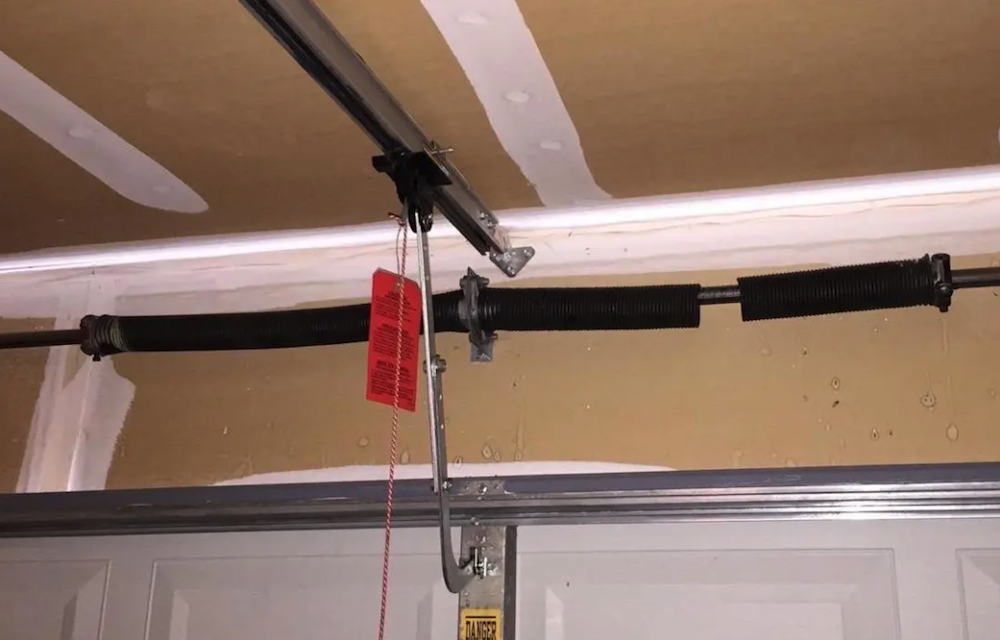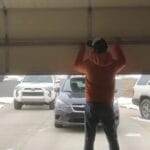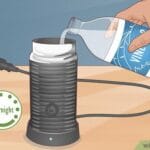Your garage door is one of those household items you probably don’t think about—until it stops working. Picture this: You’re in a rush, ready to leave for work or pick up the kids, and suddenly, the garage door won’t budge.
Panic sets in as you realize the spring is broken. You might be wondering, “Can you open a garage door with a broken spring? ” You’re not alone. Many homeowners face this challenge, and the answer isn’t as straightforward as you might hope.
Understanding the mechanics of your garage door is crucial for safety and convenience. A broken spring can turn an everyday task into a frustrating ordeal, but don’t worry. This article will guide you through everything you need to know about handling a garage door with a broken spring. Whether you’re considering a quick fix or looking for a long-term solution, we’ll help you make an informed decision. You deserve peace of mind and a hassle-free experience, so let’s dive into the nitty-gritty of garage door springs and explore how you can tackle this problem head-on.

Credit: www.youtube.com
Signs Of A Broken Garage Door Spring
A garage door with a broken spring is difficult to open and may cause safety issues. Difficulty lifting the door or uneven movement are signs of a spring problem. Professional repair is recommended for safe operation.
Knowing the signs of a broken garage door spring can save you from frustration and potential safety hazards. A malfunctioning spring can disrupt your day, and understanding these signs helps you take prompt action. Let’s dive into the specific indicators that your garage door spring might be broken, ensuring you’re prepared to handle the situation effectively.1. Difficulty In Opening The Door
Have you noticed your garage door is suddenly heavier than usual? This could be because the spring, which normally supports the weight, is broken. Without a functioning spring, the door’s weight can become too much for the opener alone, making it hard to lift.2. Door Stops Midway
Does your garage door stop halfway when opening? A broken spring might be the culprit. The spring helps balance the door, and if it’s not working, the door might not have the strength to open fully.3. Visible Gap In The Spring
Take a closer look at the spring. A broken spring often has a visible gap or separation in the coil. If you spot this, it’s a clear sign that the spring needs replacement.4. Loud Noise During Operation
Did you hear a loud bang from your garage? This could be the sound of a spring breaking. If you hear unusual noises, inspect the springs immediately.5. Garage Door Cables Appear Loose
Check the cables on your garage door. If they look loose or dangling, it might be due to a broken spring. The spring tension keeps the cables tight; if it’s broken, they lose their tension.6. Door Doesn’t Stay Up
Does your garage door close unexpectedly or doesn’t stay in the open position? This is another warning sign of a broken spring. When the spring is intact, it helps hold the door up securely. Being aware of these signs can prevent a minor inconvenience from becoming a major problem. Have you ever experienced any of these issues? If so, addressing them quickly with the help of a professional can save time and ensure safety. Remember, dealing with garage door springs can be dangerous, so it’s always best to consult an expert if you suspect a problem.Types Of Garage Door Springs
Garage doors rely on springs to function properly. Understanding the types of garage door springs can help in diagnosing issues. There are two main types: torsion and extension springs. Each type has its unique characteristics and role in the garage door operation.
Torsion Springs
Torsion springs sit above the garage door. They use torque to lift the door. This type of spring is known for its durability. Made of heavy-duty steel, they last longer. They balance the door’s weight efficiently. Installation requires professional expertise due to tension. Torsion springs provide smooth and controlled door movement.
Extension Springs
Extension springs are found on the sides of the garage door. They extend and contract to move the door. These springs operate independently of each other. They are not as durable as torsion springs. Extension springs are more affordable and easier to install. They are ideal for smaller garage doors. Regular maintenance is essential to prevent wear.
Challenges Of Opening A Door With A Broken Spring
Opening a garage door with a broken spring poses safety risks. The heavy door may fall suddenly, causing injury. Professional repair is often necessary to ensure safe operation.
Opening a garage door with a broken spring presents unique challenges that can test your patience and strength. Picture this: you’re running late for work, and as you press the remote, the door makes a grinding sound and refuses to budge. The culprit? A broken spring. This seemingly small issue can turn your routine upside down. Understanding the hurdles you face can help you decide on the best course of action.Understanding The Role Of Garage Door Springs
Garage door springs bear the weight of the door. They help in lifting it smoothly. Without a functioning spring, the door becomes incredibly heavy. You might feel like you’re trying to lift a ton with your bare hands. It’s not just inconvenient; it can be dangerous. You risk straining yourself or damaging the door further.Safety Concerns
Attempting to open a garage door with a broken spring is risky. Imagine the door slipping from your grasp. It could crash down unexpectedly. Injuries are a real threat. Not just to you but also to anyone nearby. Safety should be your priority. Consider whether it’s worth the risk before attempting any fixes yourself.Potential For Further Damage
Every attempt to force open a door with a faulty spring can lead to more damage. The door might go off track. Cables could snap. You could end up with a repair bill much higher than initially anticipated. Sometimes, a small problem can snowball into something bigger. It’s worth thinking about the long-term implications.Should You Call A Professional?
Faced with a broken spring, you might wonder: should I call a professional? The answer often is yes. They have the right tools and expertise. They can safely replace the spring. While DIY repairs might seem tempting, they can lead to more harm than good. Are you willing to risk it? Opening a garage door with a broken spring isn’t just a minor inconvenience. It challenges your safety, patience, and decision-making. As you weigh your options, consider the potential risks and rewards. Is your garage door situation manageable, or is it time for professional help?Safety Precautions To Consider
Opening a garage door with a broken spring can be dangerous. Safety should be your top priority. Before attempting to open the door, consider essential safety precautions. Ignoring them can lead to injuries or further damage.
Inspect The Door And Surroundings
Check the garage door for visible damages. Ensure the tracks are aligned. Clear any obstructions from the door’s path. This prevents accidents during manual operation.
Use Proper Tools And Equipment
Gather the right tools before starting. Use a sturdy ladder if necessary. Avoid makeshift tools that can break. Proper equipment ensures stability and safety.
Wear Protective Gear
Wear gloves to protect your hands. Use safety goggles to shield your eyes. This gear minimizes risks of injury from sharp edges or falling debris.
Seek Assistance
Ask someone to assist you. Two people can manage the door better. It reduces strain and enhances safety. Don’t attempt heavy lifting alone.
Be Cautious With Manual Operation
Lift the door slowly and steadily. Avoid sudden movements. Keep fingers away from door joints. Slow actions help maintain control.
Consider Professional Help
Hire a professional if unsure about safety. Experts handle broken springs safely. It prevents further damage and ensures proper repair.
Manual Opening Techniques
Opening a garage door with a broken spring is possible with manual techniques. Disconnect the opener. Lift the door slowly. Use caution to avoid injury.
When faced with a broken garage door spring, your first instinct might be to panic. However, you can still open your garage door manually with a bit of effort and some know-how. Manual opening techniques can save the day when you’re in a pinch and need to access your garage quickly. These methods require caution and understanding of your garage door mechanism to prevent injury or further damage. Let’s dive into how you can safely open your garage door without relying on the automated system.Using Emergency Release
The emergency release cord is your first ally in manually opening a garage door. Look for a red cord hanging from the garage door opener rail. Pulling this cord disconnects the door from the opener, allowing you to lift it manually. Before you pull the cord, ensure the door is fully closed. This prevents the door from crashing down if it’s partially open. Once detached, you can lift the door by hand. Have you ever had to use the emergency release? It can be surprisingly easy, but always be careful. Ensure you have a firm grip and your feet are positioned safely before lifting.Applying Force Carefully
Once the door is disconnected, you may need to apply some force to lift it. Use both hands and lift the door evenly to prevent it from jamming. If the door feels too heavy, don’t force it—this could cause injury. A friend once struggled with their garage door, trying to muscle it open. They quickly learned that applying steady, even force was much more effective. It’s a good idea to enlist help if the door doesn’t budge. Have you considered what might happen if you push too hard? You risk damaging the door or injuring yourself. Always prioritize safety and take your time to assess the situation before acting. By understanding these manual opening techniques, you can tackle a broken garage door spring with confidence. Always remember to prioritize safety and if the task feels too daunting, calling a professional is the best course of action. What’s your experience with manually opening a garage door? Would you try these techniques or prefer professional help? Your thoughts can help guide others in similar situations.
Credit: www.doorvana.com
Tools Needed For Manual Opening
Opening a garage door with a broken spring can be challenging. It requires manual effort and the right tools to ensure safety. Using the correct tools will make the process smoother and less strenuous.
Before attempting to open the garage door, gather the necessary tools. These tools help balance the door and ease the lifting process. Without them, the task can be risky and difficult.
Flashlight
A flashlight is essential for visibility. It helps you see the components inside the garage. This is particularly useful in dimly lit areas. A flashlight ensures you avoid any hazards.
Locking Pliers
Locking pliers are crucial for holding the door steady. They prevent the door from falling while you work. These pliers offer a firm grip, ensuring safety during manual lifting.
Adjustable Wrench
An adjustable wrench is needed to loosen nuts and bolts. It allows you to adjust the door mechanism. Using a wrench ensures the door components are secure.
Wood Blocks
Wood blocks are used for support. They help prop the door open once lifted. This prevents the door from crashing down unexpectedly. Wood blocks add stability to the process.
Safety Gloves
Safety gloves protect your hands from injuries. They offer a better grip on tools. Wearing gloves is crucial for handling sharp or heavy components. They are vital for safe manual operation.
Temporary Fixes For Broken Springs
A broken garage door spring can be a real hassle. It often happens unexpectedly, leaving your car trapped inside or outside. While it’s best to call a professional, temporary fixes can help you manage the situation. These solutions are not permanent. But they can provide short-term relief until you get expert help.
1. Use A Wooden Prop
If your garage door spring is broken, try using a sturdy wooden prop. This can help keep the door open. Place the wooden prop under the door once it’s lifted. Make sure it’s secure and stable. This allows you to move your car in or out safely. Remember, this is just a temporary fix.
2. Manually Lift The Door
Manually lifting the door requires caution. Two people should lift the door together. This reduces the risk of injury. Hold the door from both sides and lift evenly. Keep your back straight to avoid strain. Once open, secure the door in place. Use a clamp or lock if possible.
3. Avoid Using The Automatic Opener
Do not use the automatic opener with a broken spring. It can cause more damage. The opener is not designed to handle the extra weight. Using it may lead to costly repairs. Instead, rely on manual methods until repairs are made.
4. Call A Professional
Temporary fixes are not a permanent solution. A professional can replace the spring safely. This ensures your garage door works properly. Regular maintenance can prevent future issues. Always prioritize safety in these situations.
When To Call A Professional
Opening a garage door with a broken spring poses safety risks. Springs help lift heavy doors, and without them, manual opening can be dangerous. Calling a professional ensures safe repair and prevents further damage.
When your garage door spring breaks, it can feel like an immediate crisis. You might be tempted to try a DIY fix, but there are times when it’s best to call a professional. Understanding when to seek expert help ensures your safety and the smooth functioning of your garage door.Recognizing The Signs Of A Broken Spring
When your garage door refuses to open, don’t ignore it. A loud bang or a crooked door often signals a broken spring. If you notice these signs, it’s time to consider professional help.Understanding The Risks Of Diy Repairs
Trying to fix a garage door spring on your own is risky. You might think you’re saving money, but mishandling the spring can lead to injury. Professionals have the right tools and experience to handle the job safely.Ensuring Proper Tools And Techniques
Garage door springs require specific tools for repair. A professional not only has these tools but knows how to use them correctly. Attempting repairs without the right equipment can damage your door further.Safeguarding Your Warranty
Did you know that trying to fix the door yourself might void your warranty? Manufacturers often require professional repairs to keep warranties valid. Protect your investment by calling in an expert.Evaluating The Complexity Of The Repair
Some garage door repairs are more complex than they appear. Springs are under high tension and require precise adjustments. A professional can assess and fix the issue correctly the first time.Considering Long-term Benefits
Hiring a professional might seem costly upfront, but it pays off. Proper repairs extend the life of your garage door, preventing future issues. Investing in a professional service now saves you money down the road.Questions To Ask Your Repair Technician
Before hiring a repair service, consider asking a few questions. Are they experienced with your garage door model? Do they provide a warranty on their work? Knowing these answers can give you peace of mind. So, the next time your garage door spring breaks, think carefully. Is it worth the risk to fix it yourself? Or is it better to call in a professional who can ensure everything is in top shape?Preventive Maintenance Tips
Opening a garage door with a broken spring can be risky. The door might become unstable and cause injury. Regular checks and timely repairs ensure safe operation and prevent unexpected failures.
Preventive maintenance is the secret to keeping your garage door functioning smoothly and avoiding the hassle of unexpected repairs. Imagine planning a weekend trip, and just as you’re about to leave, your garage door refuses to budge because of a broken spring. By following some simple maintenance tips, you can save yourself from such inconvenient surprises.Regular Visual Inspections
Take a moment every month to visually inspect your garage door. Look for signs of wear and tear on the springs, cables, rollers, and tracks. If you notice rust or fraying, it’s a sign that maintenance is overdue. Spotting these early can prevent a minor issue from becoming a major problem.Lubricate Moving Parts
Your garage door’s moving parts need lubrication to work smoothly. Use a high-quality garage door lubricant on the springs, rollers, and tracks. This simple action reduces friction and prevents wear, extending the life of your door. Have you ever noticed how a squeaky hinge can drive you nuts? Lubrication will silence that noise and keep everything running efficiently.Check Balance
A balanced garage door will save you from future headaches. Disconnect the opener and manually lift the door halfway. If it stays in place, the balance is good. If not, it’s time to adjust the springs. This simple test ensures that the springs are not under unnecessary stress, which can lead to breakage.Tighten Loose Hardware
Vibration from daily use can loosen the nuts and bolts on your garage door. Periodically check and tighten all hardware to ensure everything is secure. This step can prevent parts from becoming misaligned, which might lead to costly repairs. It’s like tightening the screws on a wobbly chair; a little effort now saves big trouble later.Test Safety Features
Ensure that your garage door’s safety features are working correctly. Test the auto-reverse function by placing an object in the door’s path. If it doesn’t reverse immediately, it’s a clear sign that maintenance is needed. This small test can protect your family and pets from potential harm.Consult A Professional
While you can handle many maintenance tasks yourself, some issues require professional expertise. If you’re unsure about the condition of your springs or hear strange noises, don’t hesitate to call an expert. They can provide a thorough inspection and service, ensuring your garage door operates safely. By incorporating these maintenance tips into your routine, you can extend the life of your garage door and avoid the inconvenience of a broken spring. Remember, a little attention now can prevent a lot of trouble later. Have you checked your garage door lately?
Credit: www.garagedoorspecialist.net
Frequently Asked Questions
Can You Manually Lift A Garage Door With A Broken Spring?
Lifting manually is possible. But it’s heavy. Be cautious. Use assistance if needed. Safety first.
What Are Signs Of A Broken Garage Door Spring?
Door won’t open easily. Makes loud noises. Sits unevenly. Check springs regularly for wear.
Is It Safe To Use A Garage Door With A Broken Spring?
Not safe. Springs balance the door’s weight. Without them, the door can be dangerous.
How Much Does It Cost To Fix A Broken Garage Door Spring?
Costs vary. Typically between $100-$300. Depends on spring type and labor charges.
How Long Does It Take To Repair A Garage Door Spring?
Usually 1-2 hours. Professional repair ensures safety. Always hire an expert for repairs.
Conclusion
Opening a garage door with a broken spring is risky. It can lead to further damage. Safety should always be the priority. Consider contacting a professional for repairs. They have the right tools and expertise. Attempting it yourself might cause harm.
It’s not worth the risk. Garage doors are heavy and complex. Regular maintenance can prevent issues. Keep springs in good condition. Check them periodically for wear and tear. Swift action can save time and money. Ensure your garage door functions smoothly.
It’s a key part of home safety.





